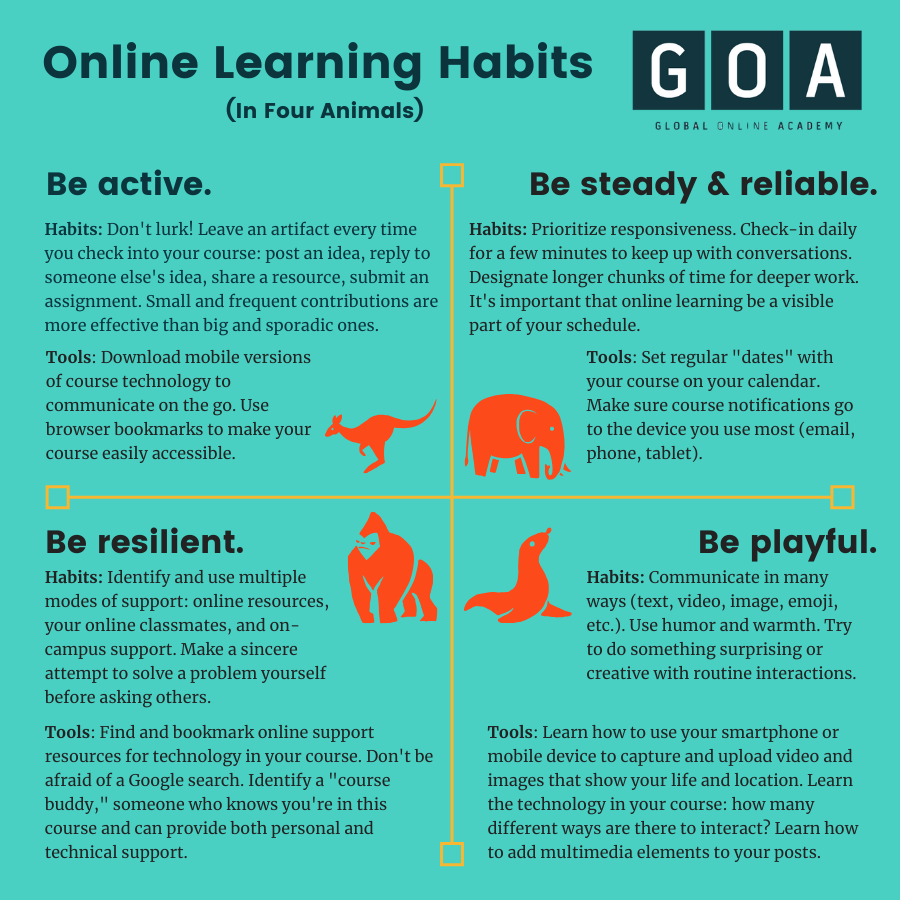The Four Habits of Successful Online Learners
What does it mean to be a successful online student? How do you know if you’ve designed a successful online learning experience?
Online environments have transformed education. The ease and sophistication of technology have put more control in the hands of individuals when it comes to making choices about what, when, where, and how we learn. This new environment demands we develop new learning habits, habits that might look different from those we developed in more traditional environments where the time, space, and pace of learning was defined for us.
GOA’s focus on relational, learner-centered design has taught us a lot about how we learn online. Whether you’re an online student or a designer of online learning experiences, these habits should be at the forefront of your mind.
Be steady and reliable
The flexibility of online learning is one of its most appealing features: you can design your own routine. What’s critical, however, is that you have a routine. Online courses often fall victim to “out of sight, out of mind” syndrome: more visible, more pressing obligations can keep pushing online learning to the bottom of our to-do lists. Especially in interactive, collaborative courses, where classmates and teachers will be counting on you to complete your share of group projects and keep interactions lively, your ability to “show up” often and with purpose can play a role in the overall quality of the experience.
Tools:
- Ensure course notifications go to the device you use most (computer, phone, tablet) in the format you prefer (email, text, alert).
- Leverage your digital calendar to designate times and reminders to engage with your course. Each week, set at least three “check-in’s” of 15 minutes or so just to respond to messages and interact with others. Set two longer, focused blocks of time to complete project work.
- Post a colorful reminder on your computer or in your workspace (maybe the above infographic!) as an everyday reminder of your online learning work.
Be active
It’s easy to “lurk” when you’re online; in fact, most of our online behavior falls into the lurking category: we scroll through a few websites, maybe click on a few links, watch a video or two. Two problems with lurking in online learning: it’s passive and it’s invisible. Well-designed online courses will ask you to do more than consume knowledge, they'll ask you to make it. Not only will your work contributing to discussions and sharing your work help you and others learn better, it will make you an active member of the course community. Set a simple goal for every time you log in: leave an artifact to make your presence known. Participate in a discussion, send a message, or share an assignment or project.
Tools:
- Download the mobile versions of online tools to ensure you can communicate and participate from anywhere, at any time.
- Use browser bookmarks to make sure your online course is visible and easily accessible every time you go online.
Be playful
Learning can be — and should be — fun. The increasing sophistication and versatility of digital environments make creative, imaginative work not only possible, but necessary. The best online learning experiences should be immersive and multisensory: you’re not just “doing work,” you’re interacting, sharing, collaborating, and creating.
Tools:
- Learn the multimedia capabilities of your course. How do you share video, audio, or images? Learn how to integrate media and links into your course submissions to enliven your argument, raise a new point, or just make a classmate smile.
- Leverage a mobile device to add variety to your course contributions. Submit a discussion post as a video recorded in your favorite place. If you prefer analog tools like pen and paper for thinking and brainstorming, take photos of your notes and share them with the class.
- Leverage social media and chat tools to connect personally with your classmates and instructor.
Be resilient
You’ll face challenges. Successful online learning demands a different set of skills than traditional classroom environments, with the added challenge of not sharing the same space (or maybe even the same time zone) as your teacher and classmates. Online courses should provide you with clear and varied pathways to find help. Familiarize yourself with them. Make time and a sincere effort to help yourself before asking for help. This is how you build the resilience to successfully learn and master new technology.
Tools:
- Bookmark help resources for your course.
- Do not fear the Google search: it is very unlikely you are the first person to face a tech issue. See if others online have shared and solved your issue.
- Find a “buddy,” either someone in your course or in your life who can be a reliable source of support, both technical and personal.
Many online courses fail because they don’t acknowledge or provide the time and space for learners to build these habits. Whether you’re participating in, leading, or designing an online learning experience, your ability to build these habits could be the difference that makes the experience meaningful for all.
Global Online Academy (GOA) offers high quality online, blended, and in person learning experiences for students and educators. Professional learning opportunities are open to any educator. To sign up or to learn more, see our Professional Learning Opportunities for Educators or email hello@GlobalOnlineAcademy.org with the subject title “Professional Learning.” To stay up to date on GOA opportunities, sign up for our newsletter here.

